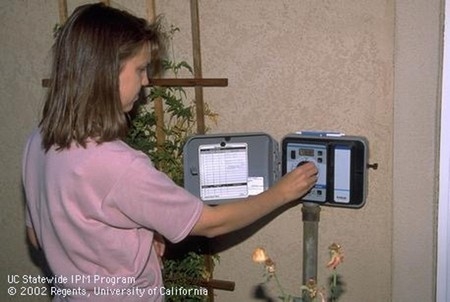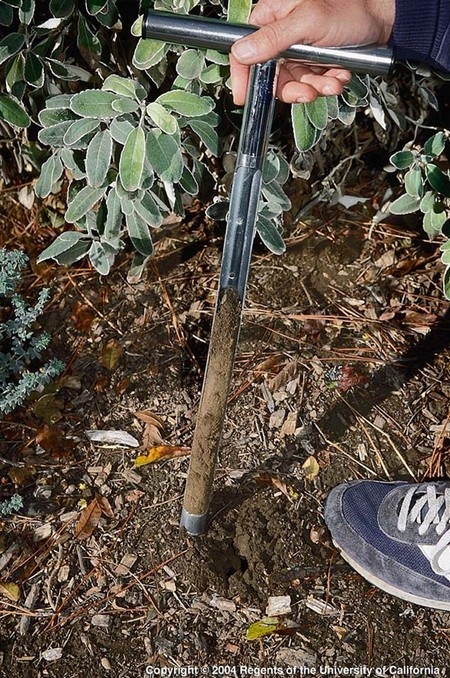Posts Tagged: Irrigation scheduling
Lawn-pocalypse! Surviving Drought
Ah, summer! The season of sunburns, pool parties, and… lawn droughts. If your once lush, green carpet now looks like a crunchy brown doormat, you're not alone. Let's dive into why your yard is staging a dramatic death scene and what you can do to...

Bermuda grass and weeds overtaking drought stressed turf grass.
CropManage Hands-on Training, Salinas CA Wed. April 3, 2024
Date: Wed. April 3rd, 2024
Course 8:30 am – 12 pm
Location: Monterey County Agriculture Conference Room
1432 Abbott St, Salinas CA 93901
- Learn how to use CropManage to support irrigation and nutrient management decisions and record-keeping for your crops.
- Learn how to set up your ranch and crops in CropManage.
- Learn about the latest updates and how CropManage can assist with Ag Order 4.0
CropManage is a free online decision-support tool for water and nutrient management of vegetables, berry, agronomic, vineyard and tree crops. Based on research and field studies conducted by the University of California Cooperative Extension, CropManage provides real-time recommendations for efficient and timely irrigation and fertilization applications while maintaining or improving overall yield.
At this free workshop, we will provide hands-on training so that you can learn to use the newest version of CropManage. Crops currently supported include many vegetables (carrots, cabbage, celery, broccoli, lettuce, tomato, spinach, etc.), berry crops (raspberry and strawberry), vineyards, tree crops (almond, walnut, pistachio, prunes, and pear), and agronomic crops (alfalfa and corn). CropManage is also available in Spanish.
Who should participate? Growers, farm managers, other farm staff, crop advisors, consultants, and technical service providers are welcome. The workshop is for both new and current CropManage users. Spanish translation will be available.
What to bring? This is a participatory workshop. Please bring a tablet or laptop computer so that you can follow along and participate in the exercises. Each participant will need a user account for CropManage. Please set up a free user account at https://cropmanage.ucanr.edu/ before the workshop. Please arrive early to set up your laptop or tablet computer on the wifi and get logged on to CropManage.
Registration is free: Please register here
by April 1, 2024. Seats are limited to the first 30 registrants.
Questions: Contact Michael Cahn at mdcahn@ucanr.edu / 831-214-3690
Agenda
8:30 – 8:50 am Registration and computer set-up
8:50 – 9:20 am Introduction
9:20 – 10:00 am Getting started with CropManage
10:00 to 10:15 am break
10:10 – 11:00 am Using CropManage for decision support and record-keeping
11:00 – 11:45 am Group exercise
11:45- 12 pm Discussion /Q&A/ wrap up
Drop-in office hours
Continuing Education Units (CEU) for Certified Crop Advisors (CCA) have been applied.
Time to Adjust Your Irrigation
Irrigation is not a ‘set and forget' thing. Your watering schedule should be adjusted each season (at least four times each year) as water needs in the landscape vary greatly from season to season. Seasonal adjustments allow us to adapt to changing weather conditions, plant growth patterns, and water availability. If your irrigation system isn't adjusted with the seasons, your plants can suffer from overwatering in the winter or underwatering in the summer.
As seasons change through the year, your plants' needs will change, too. For example, a 15-foot wide Chinese pistache tree (Pistacia chinensis) growing in Concord needs 52 gallons of water each week in July, 24 gallons per week in October, and only 8 gallons each week in January. Adjusting irrigation according to the season can decrease water use by half and your plants will be healthier.
You can calculate how much water your landscape should have for best growth. Look up the water needs of your plants in this database: https://ccuh.ucdavis.edu/wucols-db. Determine how much water is needed for each of your plants throughout the year here: https://puddle-stompers.com/waterwonk/how-much/index.php
Even knowing what your plants ‘should' need, it's best to test your soil occasionally to make sure the water you apply is getting to the right place. To test the depth of your watering, use a soil sampling tube or a small trowel to dig down 6–8 inches deep and observe the moisture level at the bottom of the hole. Get your hands dirty and learn what your soil feels like with varying moisture levels.
There can be substantial water waste when automatic watering systems are left to run on their own. Some systems come with a rain sensor function that will automatically turn off the system when it rains and others are smart controllers that adjust the schedule based on environmental factors. It might be time to upgrade your controller to take advantage of these benefits.
Some additional reminders for good irrigation practices:
Apply the right amount of water
Overwatering is more common than underwatering and can lead to more disease problems.
Water plants deeply and infrequently
The entire root zone should receive water, but let the soil dry partially in between to reduce the chance of root rot and other diseases.
Water early in the morning
Cooler temperatures and less wind will reduce evaporation, especially if using sprinklers or above-ground systems.
Avoid runoff
This happens often in clay soil and the water is simply wasted. Cycle the irrigation giving enough time for each cycle to be absorbed.
Regularly maintain your irrigation system
Check for leaks or damaged parts that could be wasting water and preventing water from getting to the right place.
Apply mulch
A 2- to 4-inch layer will reduce evaporation, minimize weed competition, and improve the soil.
See these links for more information on irrigation:
https://sonomamg.ucanr.edu/Drip_Irrigation/Drip_Irrigation_in_Different_Landscape_Situations/
https://sonomamg.ucanr.edu/Drip_Irrigation/
Help Desk of the UC Master Gardeners of Contra Costa County

adjust controller450

soil probe450
Climate-Change Resources
University of California UC ANR Green Blog (Climate Change and Other Topics) https://ucanr.edu/blogs/Green/index.cfm?tagname=climate%20change (full index)
Examples:
- Save Trees First: Tips to Keep Them Alive Under Drought https://ucanr.edu/b/~CdD
- Landscaping with Fire Exposure in Mind: https://ucanr.edu/b/~G4D
- Cities in California Inland Areas Must Make Street Tree Changes to adapt to Future Climate https://ucanr.edu/b/~oF7
Drought, Climate Change and California Water Management Ted Grantham, UC Cooperative Extension specialist (23 minutes) https://youtu.be/dlimj75Wn9Q
Climate Variability and Change: Trends and Impacts on CA Agriculture Tapan Pathak, UC Cooperative Extension specialist (24 minutes) https://youtu.be/bIHI0yqqQJc
California Institute for Water Resources (links to blogs, talks, podcasts, water experts, etc.) https://ciwr.ucanr.edu/California_Drought_Expertise/
UC ANR Wildfire Resources (publications, videos, etc.) https://ucanr.edu/News/For_the_media/Press_kits/Wildfire/ (main website)
-UC ANR Fire Resources and Information https://ucanr.edu/sites/fire/ (main website)
-Preparing Home Landscaping https://ucanr.edu/sites/fire/Prepare/Landscaping/
UC ANR Free Publications https://anrcatalog.ucanr.edu/ (main website)
- Benefits of Plants to Humans and Urban Ecosystems: https://anrcatalog.ucanr.edu/pdf/8726.pdf
-Keeping Plants Alive Under Drought and Water Restrictions (English version) https://anrcatalog.ucanr.edu/pdf/8553.pdf
(Spanish version) https://anrcatalog.ucanr.edu/pdf/8628.pdf
- Use of Graywater in Urban Landscapes https://anrcatalog.ucanr.edu/pdf/8536.pdf
- Sustainable Landscaping in California https://anrcatalog.ucanr.edu/pdf/8504.pdf
Other (Non-UC) Climate Change Resources
Urban Forests and Climate Change. Urban forests play an important role in climate change mitigation and adaptation. Active stewardship of a community's forestry assets can strengthen local resilience to climate change while creating more sustainable and desirable places to live. https://www.fs.usda.gov/ccrc/topics/urban-forests
Examining the Viability of Planting Trees to Mitigate Climate Change (plausible at the forest level) https://climate.nasa.gov/news/2927/examining-the-viability-of-planting-trees-to-help-mitigate-climate-change/
Reports and other information resources coordinated under the auspices of the United Nations and produced through the collaboration of thousands of international scientists to provide a clear and up to date view of the current state of scientific knowledge relevant to climate change. United Nations Climate Action
Scientific reports, programs, action movements and events related to climate change. National Center for Atmospheric Research (National Science Foundation)
Find useful reports, program information and other documents resulting from federally funded research and development into the behavior of the atmosphere and related physical, biological and social systems. Search and find climate data from prehistory through to an hour ago in the world's largest climate data archive. (Formerly the "Climatic Data Center") National Centers for Environmental Information (NOAA)
Think tank providing information, analysis, policy and solution development for addressing climate change and energy issues (formerly known as the: "Pew Center on Global Climate Change"). Center for Climate & Energy Solutions (C2ES)
Mapping Resilience: A Blueprint for Thriving in the Face of Climate Disaster. The Climate Adaptation Knowledge Exchange (CAKE) was launched in July 2010 and is managed by EcoAdapt, a non-profit with a singular mission: to create a robust future in the face of climate change by bringing together diverse players to reshape planning and management in response to rapid climate change. https://www.cakex.org/documents/mapping-resilience-blueprint-thriving-face-climate-disaster
Cal-Adapt provides a way to explore peer-reviewed data that portrays how climate change might affect California at the state and local level. We make this data available through downloads, visualizations, and the Cal-Adapt API for your research, outreach, and adaptation planning needs. Cal-Adapt is a collaboration between state agency funding programs, university and private sector researchers https://cal-adapt.org/
Find reports, maps, data and other resources produced through a confederation of the research arms of 13 Federal departments and agencies that carry out research and develop and maintain capabilities that support the Nation's response to global change. Global Change (U.S. Global Change Research Program)
The Pacific Institute is a global water think tank that combines science-based thought leadership with active outreach to influence local, national, and international efforts to develop sustainable water policies. https://pacinst.org/our-approach/
Making equity real in climate adaptation and community resilience policies and programs: a guidebook. https://greenlining.org/publications/2019/making-equity-real-in-climate-adaption-and-community-resilience-policies-and-programs-a-guidebook/
Quarterly CA Climate Updates and CA Drought Monitor Maps (updated each Thursday) https://www.drought.gov/documents/quarterly-climate-impacts-and-outlook-western-region-june-2022
CropManage Hands-on Workshop, San Martin CA, March 29, 2023
CropManage Hands-on Workshop
Bringing Irrigation and Nutrient Management Decision-Support to the Field
Date: Wednesday, March 29th, 2023
9:30 am – 2:30 pm
Location: Animal Services Center
Address: 12425 Monterey Road, San Martin, CA 95046
- Learn how to use CropManage to support irrigation and nutrient management decisions and record-keeping for your crops
- Learn about the latest updates to CropManage
- Learn how CropManage can assist with reporting requirements for Ag Order 4.0
CropManageis a free online decision-support tool for water and nutrient management of vegetables, berry, agronomic, and tree crops. Based on in-depth research and field studies conducted by the University of California Cooperative Extension, CropManage provides real-time recommendations for efficient and timely irrigation and fertilization applications while maintaining or improving overall yield.
At this free workshop, we will provide hands-on training so that you can learn to use the newest version of CropManage. Crops currently supported include many vegetables (carrots, cabbage, celery, broccoli, lettuce, tomato, spinach, etc.), berry crops (raspberry and strawberry), tree crops (almond, walnut, pistachio, prunes, and pear), and agronomic crops (alfalfa and corn). CropManage is also available in Spanish.
Who should participate? Growers, farm managers, other farm staff, crop advisors, consultants, and technical service providers are welcome. The workshop is for both new and current CropManage users. Spanish translation will be available. Lunch will be provided.
What to bring? This is a participatory workshop. Please bring a tablet or laptop computer so that you can follow along and participate in the exercises. Each participant will need a user account for CropManage. Please set up a free user account at https://cropmanage.ucanr.edu/ before the workshop. Please arrive early to set up your laptop or tablet computer on the wifi and get logged on to CropManage.
Registration is free: Please register here
by March 28th, 2023. Seats are limited to the first 40 registrants.
Agenda
|
9:30 – 10:00 am |
Registration and computer set-up |
|
10:00 – 10:30 am |
Introduction |
|
10:30 – 12:00 pm |
Getting started with CropManage |
|
12:00 to 12:30 pm |
Lunch break |
|
12:30 – 1:15 pm |
Using CropManage for decision support and record-keeping |
|
1:15 – 2:00 pm |
Group exercise |
|
2:00 – 2:30 pm |
Discussion / Q&A / wrap up |
CropManage Hands on Workshop Santa Clara County 2023 English
2023 CropManage Hands on Workshop Santa Clara County Spanish

